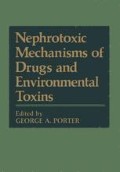Abstract
Heavy metal salts have been extensively used to study the pathophysiology of acute renal failure. There have been numerous studies which have carefully characterized the alterations in renal functions, renal hemodynamics, and vasoactive substances in heavy metal-induced acute renal failure. Based on these studies (Flamenbaum et al., 1974), it was proposed that activation of a tubuloglomerular feedback mechanism may be an important mediator for the initiation of acute renal failure. In this proposal it is assumed that heavy metal salts (uranyl nitrate or mercuric chloride) initially interact with epithelial cells of the renal tubule so as to reduce fluid and electrolyte transport primarily in early nephron segments. As a consequence of the altered transport function in the early segments, the composition of the fluid delivered to the distal nephron and macula densa is changed. The changed fluid composition results in increased renin release and thereby activation of tubuloglomerular feedback (Schnermann et al., 1970). This latter step results in the observed decrease in glomerular filtration rate and changes in renal hemodynamics. The renal hemodynamic changes in turn will tend to augment and perpetuate the initial tubular dysfunction so that the usually negative feedback mechanisms for tubuloglomerular feedback do not become operative.
Access this chapter
Tax calculation will be finalised at checkout
Purchases are for personal use only
Preview
Unable to display preview. Download preview PDF.
References
Andreoli, T. E., 1973, On the anatomy of amphotericin B-cholesterol pores in lipid bilayer membrane, Kidney Int. 4:337.
Barron, E. S. G., Muntz, J. A., and Gasvoda, B., 1948, Regulatory mechanisms of cellular respiration. I.: The role of cell membranes; uranium inhibition of cellular respiration, J. Gen. Physiol. 32:163.
Cleland, W. W., 1964, Dithiothreitol, a new protective agent for SH groups, Biochemistry 3:480.
Demis, D. J., Rothstein, A., and Meier, R., 1954, The relationship of the cell surface to metabolism, X: The location and function of envertase in the yeast cell, Arch. Biochem. 48:55.
Finn, A. L., 1968, Separate effects of sodium and vasopressin on the sodium pump in toad bladder, Am. J. Physiol. 215:849.
Flamenbaum, W., Huddleston, M. L., McNeil, J. S., and Hamburger, R. J., 1974, Uranyl nitrate induced acute renal failure in rat: micropuncture and renal hemodynamic studies, Kidney Int. 6:408.
Frenkel, A., Ekbald, E. B. M., and Edelman, I. S., 1975, Effect of sulfhydryl reagents on basal and vaso-pressin-stimulated Na+ transport in toad bladder, in: Biomembranes 7 (H. Eisenberg, E. Katachel-ski-Katzir, L. A. Manson, eds.), Plenum Press, New York, p. 167.
Leslie, B. R., Schwartz, J. H., and Steinmetz, P. R., 1973, Coupling between Cl- absorption and HCO3 - secretion in turtle bladder, Am. J. Physiol. 225:610.
Lichtenstein, N. F., and Leaf, A., 1969, Effect of amphotericin B on the permeability of toad bladder, J. Clin. Invest. 44:1328.
Reuss, L., and Finn, A. L., 1975, Dependance of serosal membrane potential on mucosal membrane potential in toad urinary bladder, Biophys. J. 15:71.
Riggs, A., 1959, Hemoglobin structure, in: Sulfur Protein (R. Benesch, ed.), Academic Press, New York, p. 173.
Riggs, A., and Walbach, R. A., 1956, Sulfhydryl group and the structure of hemoglobin, J. Gen. Physiol. 39:585.
Rothstein, A., 1959, Cell membrane as site of action of heavy metals, Fed. Proc. 18:1026.
Schnermann, J., Wright, F. S., Davis, J. M., Stockelberg, W. V., and Grill, G., 1970, Regulation of superficial nephron filtration rate by tubuloglomerular feedback, Pfluegers Arch. 318:147.
Schwartz, J. H., and Flamenbaum, W., 1976, Heavy metal-induced alteration in ion transport by turtle urinary bladder, Am. J. Physiol. 230:1582.
Steinmetz, P. R., 1974, Cellular mechanism of urinary acidification, Physiol. Rev. 54:890.
Steinmetz, P. R., and Lawson, L. R., 1970, Defect in urinary acidification induced by amphotericin B, J. Clin. Invest. 49:596.
Webb, J. L., 1966, Enzymes and Metabolic Inhibitors, Volume II, Academic Press, New York, p. 1237.
Author information
Authors and Affiliations
Editor information
Editors and Affiliations
Rights and permissions
Copyright information
© 1982 Springer Science+Business Media New York
About this chapter
Cite this chapter
Schwartz, J.H. (1982). Effect of Heavy Metals on Sodium Transport in Vitro . In: Porter, G.A. (eds) Nephrotoxic Mechanisms of Drugs and Environmental Toxins. Springer, Boston, MA. https://doi.org/10.1007/978-1-4684-4214-4_3
Download citation
DOI: https://doi.org/10.1007/978-1-4684-4214-4_3
Publisher Name: Springer, Boston, MA
Print ISBN: 978-1-4684-4216-8
Online ISBN: 978-1-4684-4214-4
eBook Packages: Springer Book Archive

